1. Introduction
Sony CRX 200E IDE DDCDR-W - Page 1
Introduction:
Sony has been the company that, alongside with Philips, have developed most
of the well known CD patterns. On July 2000 Sony announced a new CD format called
"Double Density", which promised to double (X2 times) the existing
CD capacity up to 1.3GB. The new format has been described by the new "Purple
Book" standard. In their initial press release, Sony stated:
 "...The
Double Density CD formats are designed to provide a natural migration path for
both consumers and manufacturers alike, as the new formats offer a low-cost
solution to high capacity discs that inherit the basic specifications of the
CD formats. This allows manufacturers to utilize their current CD technologies
and production facilities to manufacture Double Density CDs. The recent evolution
of high performance processors and high capacity hard disk drives has empowered
the PC to handle large audio, video and still image files. That in turn has
raised the need for higher capacity CDs to store and share those files with
other devices at the lowest running cost. In light of this market demand, Sony
decided to develop the Double Density CD formats. The target market of CRX-200E-RP
is 5% of high-end CD-R/RW after market, which is estimated approximately 17
million units world wide at the initial stage..."
"...The
Double Density CD formats are designed to provide a natural migration path for
both consumers and manufacturers alike, as the new formats offer a low-cost
solution to high capacity discs that inherit the basic specifications of the
CD formats. This allows manufacturers to utilize their current CD technologies
and production facilities to manufacture Double Density CDs. The recent evolution
of high performance processors and high capacity hard disk drives has empowered
the PC to handle large audio, video and still image files. That in turn has
raised the need for higher capacity CDs to store and share those files with
other devices at the lowest running cost. In light of this market demand, Sony
decided to develop the Double Density CD formats. The target market of CRX-200E-RP
is 5% of high-end CD-R/RW after market, which is estimated approximately 17
million units world wide at the initial stage..."
- How did they do it?
 The
high capacity of the Double Density CD format is realized by a few simple modifications
to the common CD format. In order to increase data density, track-pitch and
minimum pit length are miniaturized to increase the data capacity from 650MB
to 1.3GB. This capacity is achieved by utilising a conventional
780 nm laser and using a NA of 0.50 or 0.55, thus reducing the track pitch (by
1.45) and the minimum pit size (by 1.33):
The
high capacity of the Double Density CD format is realized by a few simple modifications
to the common CD format. In order to increase data density, track-pitch and
minimum pit length are miniaturized to increase the data capacity from 650MB
to 1.3GB. This capacity is achieved by utilising a conventional
780 nm laser and using a NA of 0.50 or 0.55, thus reducing the track pitch (by
1.45) and the minimum pit size (by 1.33):


 >
>
|
Comparison of DDCD and CD formats
|
|
|
Double Density CD
|
Conventional CD
|
|
Data Capacity
|
1.3GB (2048 B/sector)
|
CD-ROM (Mode1)/-R/-RW: 650MB (2048 B/Sector)
|
|
Wavelength
|
780nm780nm
|
|
Objective Lens
|
Read: NA=0.50
Read/Write: NA=0.55
|
Read: NA=0.45
Read/Write: NA=0.50
|
|
Disc Size
|
Diameter: 120mm, 80mm
Thickness: 1.2mm
|
|
Track Pitch
|
1.1micrometer
|
1.6micrometer
|
|
Minimum Pit Length
|
0.623micrometers
|
0.833micrometers
|
|
Scanning Velocity
|
0.90 m/s
|
1.2 to 1.4 m/s
|
|
Error Correction
|
CIRC7
|
CIRC
|
|
Modulation
|
EFM
|
To accommodate higher physical bit density, a parameter in the error-correction
scheme (CIRC) has been changed, and the address format (ATIP) has been expanded.
Sony stated in the original press release that "...A copy control scheme
will be included in the format to meet the increasing demands for secure content
protection...".
This copy control scheme, as we can understand, means that you can not
write AudioCD format in DDCD-R/RW media! Yeap folks. Sony denied any relation
of the DDCD format with Audio CDs (and with all possible piracy issues). Just
imagine that a DDCD-R media will be able to store 148mins of music... Someone
might say that this is not a real problem since DDCD media is not playable from
current stand alone players/CD-ROMs. That is true for the present situation,
but what about the future? Sony's future CD-ROMs/CDR-W drive will probably support
the DDCD format, and then this *problem* will become a reality. Of course you
are able to write Mp3 files (as data tracks).
 -
Media:
-
Media:
 The
DDCD media can be either 80mm and/or 120 mm disc size. There will be 3 types
of DDCD media: Read Only (DDCD-ROM), Write Once (DDCD-R), and Rewritable (DDCD-RW)
with the same capacities. As you can understand, due to different physical structure,
the DDCD Medium is not backwards compatible with the existing CD-ROM/DVD-ROM/CDR-W
drives. This means that the media will only be playable in the devices that
contains the "DDCD" logo.
The
DDCD media can be either 80mm and/or 120 mm disc size. There will be 3 types
of DDCD media: Read Only (DDCD-ROM), Write Once (DDCD-R), and Rewritable (DDCD-RW)
with the same capacities. As you can understand, due to different physical structure,
the DDCD Medium is not backwards compatible with the existing CD-ROM/DVD-ROM/CDR-W
drives. This means that the media will only be playable in the devices that
contains the "DDCD" logo.
 For
now there are not many manufacturers who ship DDCD-R/RW media. Only Sony and
Verbatim sell DDCD-R/RW, and we haven't heard of any other media manufacturers
going for it. Actually even Verbatim have announced DDCD media they haven't
shipped in retail market due to low demand. Our guess is that they are waiting
to see whether the new standard will be widely accepted from end users, in order
to proceed to mass production. Below is a comparison chart beetween the CD/DDCD
formats and the media that can be read/written:
For
now there are not many manufacturers who ship DDCD-R/RW media. Only Sony and
Verbatim sell DDCD-R/RW, and we haven't heard of any other media manufacturers
going for it. Actually even Verbatim have announced DDCD media they haven't
shipped in retail market due to low demand. Our guess is that they are waiting
to see whether the new standard will be widely accepted from end users, in order
to proceed to mass production. Below is a comparison chart beetween the CD/DDCD
formats and the media that can be read/written:

As you may notice the DDCD drives can playback all CD media and DDCD media.
The normal CD-RW drives simply cannot read the DDCD-R/RW media.
- Recording methods:
The DDCD format is supposed to support: "DAO, SAO, TAO" formats.
Our tests showed that only "TAO" writing mode, Packet Writing and
Multi-Session are supported. In the case of Packet Writing we will have 2 modes:
Variable Packet Writing and Fixed Packet Writing (no futher information
is given about their main differences). There seems to be a limitation with
MultiSession of the DDCD and CD format as the following table shows:

As it is obvious, you cannot backup CDs which contain multiple sessions in
DDCD-R/RW media, and vice versa.
- Recording speeds:
The DDCD format has mainly 2 different writing/re-writing speeds. The DDCD-R
media can be written at 12x and the DDCD-RW media at 8x. In other words, you
will need around 12 minutes to burn a full DDCD and around 15 minutes for a
full DDCD-RW media. We hope that newer DDCD models will support higher recording
speeds (16x) and, why not, a full 10x re-write mode.
- Use:
The product sheet of CRX200E model says that you can:
- Backup your most important files
- Store large or high quality digital photos
- Move your favorite music tracks from your HD
- Store 2 hours MPEG-1 digital motion pictures
- Store Internet homepage's multimedia contents
- Distribute and share data
Have you noticed that almost every single use contains the word "store"
and "backup"? This is where the DDCD is aimed at!
- Future:
We cannot say much about the new CD standard from Sony and Philips, at least
for now... Only time will tell. The main problem is that the DVD-R recording
format is here, even in not so affordable prices for the masses (1000$ for the
drive and around 10$ for the blanks). On the other hand, the DDCD format offers
lower capacity (1.3GB) BUT at a much lower initial price cost (249$) and of
course the media is very cheap (2-3$).
Don't forget about the licence patterns: In order for someone to use the new
DDCD format, he is oblidged to pay fees to Sony and Philips. If prices are low
maybe someone will be interested in supplying such drives, but so far no other
manufacturer have announched anything...Therefore we must see the DDCD format
not as a CD standard that tends to replace the existing CD or possible DVD-R/RW
formats, but as a new proposal mainly for backup proposes. I know many people
who wish to have some extra MBs in their 74 or 80 minute CDs to fit more data.
The DDCD is designed to satisfy the needs of those people.
- Wait a minute... Nowadays there are 90, 99 and 120minutes around...
What about those?
Yes, you are right! But those are out of the present standards and most
manufacturers don't support them (at least officially). The interesting point
is that all 90, 99 and 120minute CDs are backwards compatible with existing
CD-players/CD-ROMs/DVD-ROMs! From our experience we can say that 90minute CDs
are the best solution for people who would like additional storage capacity,
since 99 and 120minute CDs are not supported from many drives and probably due
to compatibility problems. But then again, this applies for now. Maybe one day
all manufacturers will decide to support the increased capacity media, which
would work in the normal recorders. Also keep in mind that all Sony drives do
not support overburning...Imagine the CRX200E being able to write 90 and 99minutes!
- What about MultiLevel (ML) recording?
As you might know MultiLever recording promises around 2.3GB of data written
at 36x speed! How can the DDCD format stand upon it? The secret is timing...DDCD
is here NOW! You can buy it in yout local store. ML recording devices will come
by the end of 2001 from various manufacturers (TDK, Plextor, Sanyo and Yamaha).
2. Installation
Sony CRX 200E IDE DDCDR-W -
Page 2
Supplied Package:
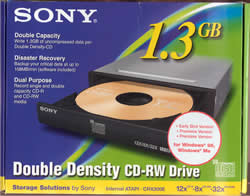 The
package supplied was the retail European version and included: The drive itself,
a quick installation guide, 1 DDCD-R blank, 1 DDCD-RW blank, mounting screws
and a very useful CD-R pen.
The
package supplied was the retail European version and included: The drive itself,
a quick installation guide, 1 DDCD-R blank, 1 DDCD-RW blank, mounting screws
and a very useful CD-R pen.
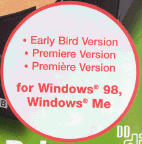 If
we take a closer look at the retail package we will see the "Early Bird
Version" stamp. This stamp mostly is placed for the software and not for
the hardware...In the European market, drive ships with WinOnCD 3.8/DirectCD
5.0 as the main CDR recording software. However,in France/US/Japan
If
we take a closer look at the retail package we will see the "Early Bird
Version" stamp. This stamp mostly is placed for the software and not for
the hardware...In the European market, drive ships with WinOnCD 3.8/DirectCD
5.0 as the main CDR recording software. However,in France/US/Japan  the
drive ships with Prassi PrimoCD Plus and Sony abCD! Actually our version contained
both software packages- WinOnCD/DirectCD came in written CDR, Prassi PrimoCD
Plus in pressed CD. The final European drive will in addition: Dantz Retrospect
Express, MusicMatch JukeBox, PhotoStudio, Photobase, VideoImpression.
the
drive ships with Prassi PrimoCD Plus and Sony abCD! Actually our version contained
both software packages- WinOnCD/DirectCD came in written CDR, Prassi PrimoCD
Plus in pressed CD. The final European drive will in addition: Dantz Retrospect
Express, MusicMatch JukeBox, PhotoStudio, Photobase, VideoImpression.
There was also a postcard inside the package, which allows the buyer to get
the full software when it is available for free. Retail users will not find
that, since it will come with final version software.
 Let's
take a look at the drive itself. The drive looks so different than what Sony
has posted in the Japanese homepage. The drive has a black colouring and tray,
and the specifications and logos are with open colour shade.
Let's
take a look at the drive itself. The drive looks so different than what Sony
has posted in the Japanese homepage. The drive has a black colouring and tray,
and the specifications and logos are with open colour shade.
Sony makes clear that the drive supports DDCD (Double Density) format by displaying
the new standard logo in the middle of the tray door. In addition, for all those
who don't understand it, the "1.3GB" letters are there to make it
clear. The drive has only one LED and the usual controls: eject button, headphone
input jack and volume potentiometer. Finally, supported speeds are shown by
the "12x/8x/32x" specification logo:

On the back of the drive we find the usual connectors (IDE interface and Power),
the jumpers for setting the drive to Master/Slave option, analogue and digital
audio output connectors, and 2 factory reserved jumpers (not used).

Installation:
 ATAPI
CDR-W drives are very easy to install. Just decide what the drive should be,
master or slave, set the appropriate jumper and you are all set! After booting
up your system, the DDCDR-W identifies itself as the "Sony CD-RW CRX200E".
We unchecked the Auto Insert notification, checked DMA and rebooted. The drive
was a March 2001 model with firmware revision v1.0f.
ATAPI
CDR-W drives are very easy to install. Just decide what the drive should be,
master or slave, set the appropriate jumper and you are all set! After booting
up your system, the DDCDR-W identifies itself as the "Sony CD-RW CRX200E".
We unchecked the Auto Insert notification, checked DMA and rebooted. The drive
was a March 2001 model with firmware revision v1.0f.
- CDR Software:
 Here
is what was kinda messy. The drive, as we mentioned earlier, will ship with
WinOnCD 3.8/DirectCD 5.0 and in some other countries with Prassi PrimoCD Plus/abCD.
For testing proposes we used the above software for the DDCD tests and Nero
5.5.1.8 for some CD/DDCD tests. Ahead InCD v2.13 supported the drive's increased
capabilities and also InstantCD/DVD 6.0 supposed to do that too (but failed
in real life tests with DDCD-RW media). Padus DJ 3.00.783 had problems with
the DDCD media, so an update was required in order to support the new format:
Here
is what was kinda messy. The drive, as we mentioned earlier, will ship with
WinOnCD 3.8/DirectCD 5.0 and in some other countries with Prassi PrimoCD Plus/abCD.
For testing proposes we used the above software for the DDCD tests and Nero
5.5.1.8 for some CD/DDCD tests. Ahead InCD v2.13 supported the drive's increased
capabilities and also InstantCD/DVD 6.0 supposed to do that too (but failed
in real life tests with DDCD-RW media). Padus DJ 3.00.783 had problems with
the DDCD media, so an update was required in order to support the new format:

Usually we don't post the product specifications, but since the CRX200E supports
a new standard we will make an exception:
|
MAIN SPECIFICATIONS
|
| Model Code |
CRX200E |
| Interface |
Ultra DMA/33 ATAPI |
| Write speed DD-R/CD-R |
12x (1,800 kB/s) |
| Write speed DD-RW/CD-RW |
8x (1,200 Kb/s :High speed) |
| Read speed |
13 - 32x (1,950 - 4,800 kB/s) |
| Transfer rate (burst) |
PIO Mode 4 (16.7 MB/s)
Multiword DMA Mode 2 (16.7 MB/s)
Ultra DMA (33 MB/s) |
| Average access time |
125 ms (random) |
| Buffer memory size |
8 MB |
| Dimensions (w x h
x d) |
146 x 41 x 197 mm |
| Writing methods supported* |
Disc at Once, Track at Once, Session
at Once, Fixed and Variable Packet |
| Formats and modes supported |
DDCD, CD-DA, CD Extra, CD Text,
CD-ROM, CD-ROM XA, CD-I, CD-I Ready, Video CD, Photo CD (single- and Multisession) |
| Supported operating systems |
Windows 98/2000/Me |
| Supplied software |
Sony Application Software: Roxio
WinOnCD 3.8, DirectCD, Dantz Retrospect Express, musicmatch jukebox, ArcSoft
PhotoBase™, PhotoStudioand VideoImpression |
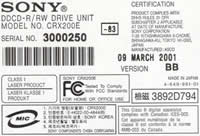 Test
Machine:
Test
Machine:
WinMe OS
Soyo 7VCA
Celeron II 566 over clocked to 850 MHz
128MB SDRAM PC 133
WD 18GB UDMA 66
Quantum Fireball EX 6.4 GB UDMA 33
DAWI 2975 - PCI (ULTRA) SCSI Host Adapter
ATI AIW 128
PlexWriter PX-W1210A firmware v1.07 (TLA#000)
Ricoh MP7125A firmware v1.00
Acer 1208 firmware v9.GB
Sony CRX200E firmware v1.0f
3. Data Tests
Sony CRX200E
IDE DDCDR-W- Page 3
Data Tests
Test Method:
- SCSI Mechanic v3.0 & CD Speed 99 v0.80 Tests: With these tests
we attempt to compare the I/O performance of Sony's CRX200E to other various
CDR-W drives (see charts) and we also checked the drive performance. In all
of the following tests we used a pressed CD containing PlexTools v1.08 original
CD.
- SCSI Mechanic v3.0 results:

The Sony CRX200E performed fairly good in the SCSI Mechanic test. The drive
had the lower score in both "Average Random I/O" and "Average
Sequential I/O" tests results. In the "Average Same Sector I/O"
tests the drive managed its internal cache very succesfully and gave a very
good output (10829 KB/s).
- CD Speed 99 results: (click here
to see the CD Speed 99 graph)

The CD Speed 99 results confirmed our previous tests results. The Sony drive
gave back the lowest average reading speed mark (only 23.85x) and it seems that
it needs extra care from Sony engineers to gain some reading performance.
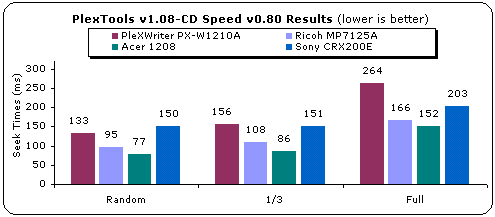
The seek times for Sony CRX200E are also increased compared to the competition.
The drive has an average 150ms random seek time, which is almost two times higher
than Acer's CRX1208!
- DDCD-R Media
We burned a DDCD-R media with data up to 1.3GB and the graph from CD Speed
99 was out of the usual limits with an average reading speed of 21.72x. The
author of CD Speed has kindly offered us the latest beta of CD Speed 99 (0.82)
which now has selectable testing scale and improved arlgorithms. The final result
is much better than with the previous (0.80) build. With the new version the
drive's average reading speed was 24.35x:
 >>
>> 
4. RW reading tests
Sony CRX200E IDE DDCDR-W-
Page 4
RW reading tests
- CD Speed 99 HS-RW tests: (click here
for the CD Speed 99 graph)
For the RW tests we used the Verbatim HS RW media written at 8x speed. The
Sony CRX200E performed quite good, giving around 16.05x as the average reading
speed. The competition seems faster, except for the Acer CRX1208:

- CD Speed 99 DDCD-RW Tests:
According to CD-Speed 99 reports, the drive reads a DDCD-RW media with 8x speed.
Seek times are much higher than with normal HS-RW media, and CPU usage for 8x
reading seems very high (31%):
 >
> 
CloneCD Tests
- Procedure:
We used CloneCD (v3.0.0.14) and 3 original CDs (Rally Masters, V-Rally 2
Expert and Euro 2000) in order to test the reading time of Sony CRX200E. We
also tested the reading performance with backups of the original CDs, since
the reading speed varies between original and backup media. For comparison reasons
we added the results of the already tested PleXWriter PX-W1210A, Acer 1208 and
Ricoh MP7125A.The following picture shows the Sony CRX200E reading/writing capabilities:

- Results:
a) SafeDisc Results: Euro 2000 (Total: 257982 sectors - 10141 bad sectors)
- Reading Speed: Max

The Sony CRX200E had the same performance with both pressed and cdr media.
Its performance is not bad but not as good as what PleXWriter PX-W1210A can
deliver.
b) LaserLock Results: Rally Masters (Total: 321528 sectors - 6317 bad
sectors) - Reading Speed: Max

In the LaserLock protected CDs test, the Sony drive achieved the second best
performance in both tests with pressed/cdr media.
c) SecuROM Results: Vrally2 Expert - 343767 sectors

The Sony CRX200E can read SubChannel data and, as the test results show, fast
enough!
5. DAE Tests
Sony
CRX200E IDE DDCDR-W - Page
5
DAE Tests
- Test Method:
We used CD DAE 99 v0.21 beta and EAC v0.9 prebeta 9 software in order to
check the DAE performance of the Sony CRX200E with various AudioCDs (both pressed
and CDR). The posted DAE results are the average of both applications, but the
CPU usage was only taken from CD DAE 99, since EAC occupies the system a lot
more. As a last note, we used the "BURST" reading mode of EAC. We
made a full CD Rip starting from the first to the last track of the CD. The
Average DAE reported speed along with the CPU Usage is displayed in the test
graphs.
- DAE features:
 We
used EAC v0.9 prebeta 9 to examine the drive's features. As the program reported,
the drive does "Caching" data, supports "Accurate Stream"
and can't utilise "C2" error info.
We
used EAC v0.9 prebeta 9 to examine the drive's features. As the program reported,
the drive does "Caching" data, supports "Accurate Stream"
and can't utilise "C2" error info.
- Pressed AudioCD results: (click here
to see the CD Speed 99 graph)
The Sony CRX200E has its DAE speed locked at 12x (max). That gives the drive
a slight disadvantage over the competition from other drives, since they support
32x DAE (max) according to their specifications. The Sony CRX200E didn't like
our test disc with the CD Speed 99 and refused to finish the test. We then tried
it with other pressed CDs and didn't have any problem with them:
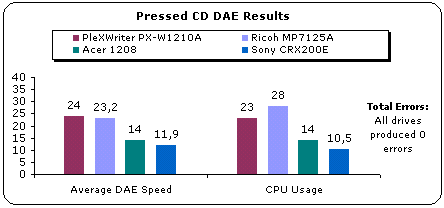
- CDR AudioCD results: (click here
to see the CD Speed 99 graph)
The Sony drive continues to have its DAE speed locked at 12x with CDR media.
The drive's average ripping speed was 11.9x which is somewhat slow compared
to the competition:

- Advanced DAE Quality

The CD-Speed 99 Advanced DAE Quality test revieled a possible problem in Sony's
CRX200E DAE capability. The drive produced 1 sync and 99 data errors, which
costed the perfect 100 score, and finally achieved a 99.2 quality score... The
test also reported that the drive cannot read CD-Text, something that was confirmed
with Feurio's build-in CD-Text player, and can read SubChannel data:

- Ripping 90 and 95mins AudioCDs
The Sony CRX200E recognized the 90min AudioCD without any problems but failed
entirely with 99min CDs. Also, as CD Speed 99 reported, the drive stops reading
at around 88minutes :

- DDCD-R Media results:
Since the drive doesn't support writing Audio tracks in DDCD media, such
tests were not performed :(
6. CDR Tests
Sony
CRX200E IDE DDCD-RW - Page
6
CDR Tests
 The
Sony CRX200E supports 12x writing speed and is equipped with 8MB of buffer in
order to avoid possible buffer underruns. The competition however supports anti-coaster
technologies (BURN-Proof, JustLink, SeamLess Link), the lack of which is a negative
for the possible buyer of Sony's proposal. We used the CD Speed 99 build-in
writing speed test which confimed the 12x writing speed (12.02x average):
The
Sony CRX200E supports 12x writing speed and is equipped with 8MB of buffer in
order to avoid possible buffer underruns. The competition however supports anti-coaster
technologies (BURN-Proof, JustLink, SeamLess Link), the lack of which is a negative
for the possible buyer of Sony's proposal. We used the CD Speed 99 build-in
writing speed test which confimed the 12x writing speed (12.02x average):

- Procedure: We tested the Sony CRX200E with Nero v5.5.1.8, Prassi
PrimoCD Plus v1.5.730, CloneCD v3.0.0.14, Padus DJ v3.00.780 software, and with
the following media: Verbatim 74min (16x) & 80min (16x), Mitsui 74min (16x),
Prodisc 80min (16x) and with TDK/Plextor/Verbatim 74min HS RW. We did notice
some problems with Prodisc 16x media when writting at 12x. After 3 minutes we
got an error message "...Medium Error: No Seek Complete...". When
we tried at 8x it worked fine. The final retail European package will come with
WinOnCD/DirectCD package... We tried both, but for some reason our system hang
right after the installation. :(
- CD-R Tests:
We created a "DataCD" job with data slightly more than 74mins
(74:03:65). We burned the same job with all 4 CDR-W drives:
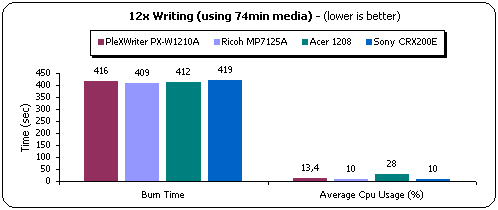
As you can see, the Sony CRX200E has the largest burning time among the four
competitor drives. The drive is around 10 secs slower than Ricoh 7125A and 7
secs slower than Acer 1208!
- 80min CDs:
In our normal burning tests the 80min CD contains slightly more than 80min
data (80:02:16) but since the Sony drive doesn't support overburning we had
to remove some of the data in order for the project size to fall back to 79:59minutes.
So the posted 80min burning time is actually lower than the expected real one
(2-3 seconds higher):
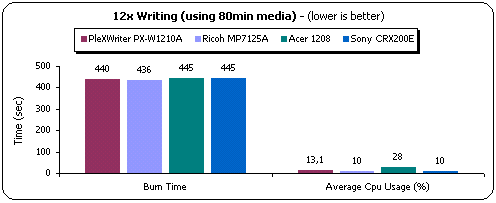
The Sony CRX200E is again the slower drive since it gives the higher recording
time (real time is 447secs). The Ricoh MP7125A is faster with 11 secs gap and
the Acer 1208 is slightly faster with 2 secs...
- Overburning Tests:
No such tests took place since Sony CRX200E simply doens't support overburning!
This is another negative issue since nowdays we cannot burn 90 and/or 99min
CDs. But what does Sony have to say about this?
The following text comes directly from the Japanese homepage: "...You
can use the 700MB (80 minutes) but not the 900MB (99 minutes) CDs. The 900MB,
which is sold from the part manufacturer (99 minutes) doesn't comply to the
standard "Orange Book", which decides the specification of CD-R/RW.
The SONY CD-R/RW drives guarantees the compatibility of read/writing of the
CD-R/RW disk which satisfies the specification of "Orange Book"...."
- AudioCD Tests:
 We
created several Audio CDs (including CD-Text). Nero 5.5.1.8 had some problems
burning AudioCDs with CD-Text, and we kept getting the same error message shown
on your left (with various media). Therefore for making AudioCDs with CD-Text
we used Prassi PrimoCD Plus and all produced CDs were played without any problem
in the same drive.
We
created several Audio CDs (including CD-Text). Nero 5.5.1.8 had some problems
burning AudioCDs with CD-Text, and we kept getting the same error message shown
on your left (with various media). Therefore for making AudioCDs with CD-Text
we used Prassi PrimoCD Plus and all produced CDs were played without any problem
in the same drive.
- CloneCD Tests:
 The
Sony CRX200E supports DAO-RAW and SAO writing modes as the latest CloneCD reports.
The drive also supports "Simulation". Our test results confirmed that
the drive works with DAO- RAW.
The
Sony CRX200E supports DAO-RAW and SAO writing modes as the latest CloneCD reports.
The drive also supports "Simulation". Our test results confirmed that
the drive works with DAO- RAW.
- SD2 Support:
For the SD2 test we used the "No One Lives For Ever" CD title.
We used Sony CRX200E both as reader/writer. The produced backup didn't play
using the same driver or any drive we tested.
- 8cm mini CDs:
The Sony CRX200E supports 8cm mini CDs only for reading. Sony states: "...Both
12cm and 8cm CDs can be read, but only the 12cm can be written. When a special
shape other than the circle is being used (star type and heart etc), please
do not use, because there is chance of breakdown...". We did performed
several simulation burning tests with 8cm miniCDs which were completed without
any problem. However we cannot guarantee that real burn will work.
- Buffer Underrun tests:
The Sony CR200E doesn't support any anti-coaster technology. Instead it
features 8MB of Buffer in order to solve this problem. As you can understand,
under a light use you won't have problems, but if you start overdoing it then
coasters will come aboard :-)
Verdict of CDR Results:
The Sony CRX200E general performance with CDR media didn't show any serious
problems. The drive seems to need around 10more secs than others to finish the
same task (different software didn't do any good, as our tests showed) which
is something noticeable. Also it doesn't support overburning, which means you
can forget about 90 and 99min CDs. On the other hand, it supports DAO-RAW, but
failed to backup SD2 protected CDs, like most of the modern drives. Finally,
the drive doesn't support any kind of anti-coaster technology, which would make
it more attractive to the users eyes...
DDCD-R
Tests
As we mentioned earlier, the Sony CRX200E supports 12x writing with DDCD-R
media. The retail package contained only one piece of DDCD-R media so our tests
were limited to only one burn :(. When more DDCD-R media arrives we will update
our review. I know what you are thinking... How much data can a DDCD-R media
hold? Prassi PrimoCD Plus has the answer:

As you can see the DDCD-R media can hold up to 148:09minutes or 1.302.21MB!
Let's try to burn that capacity now. For our burn test we used Nero 5.5.1.8,
which however was not the best solution..Why? Cause Nero's bottom bar has limit
up to 800MB, while Prassi PrimoCD Plus goes up to 1.4GB. But for our tests we
needed a burning time, which Prassi PrimoCD doesn't offer. Anyway, here are
the test results of our one and only burning attempt,and various simulation
times:
|
Burning Speed
|
Time
|
CPU Usage
|
|
12x
|
12:57 (real burn)
|
11%
|
|
12:26 (simulation)
|
|
8x
|
18:34 (simulation)
|
7%
|
|
4x
|
36:59 (simulation)
|
4%
|

For burning a full DDCD-R media at 12x you will need around 13minutes. The
simulation time was much lower (12:26). If you are not in a hurry the drive
supports 8x and 4x writing speeds with DDCD-R media.
With the DDCD format, the writing mode is ONLY TAO Mode2/XA! We tried to burn
at DAO with Nero but we encountered the following error message:

Also the Prassi PrimoCD Plus (that supports the DDCD format officially) offers
only TAO mode, which proves our claims:

What if you try to record an AudioCD at DDCD-R/W media? The following error
message apears:

The Sony CRX200E refuses to write since AudioCD is not allowed in the "Purple
Book" standard.
7. RW Writing Tests
Sony
CRX200E IDE DDCDR-W - Page
7
RW Writing Tests
We used Nero 5.5.1.8 for writing CDs at the maximum RW speed for all the tested
drives. The Sony CRX200E/Acer CRW1208 support only 8x and the rest drives 10x:
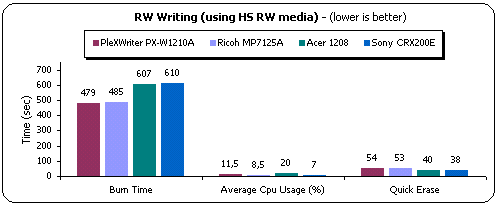
The Sony CRX200E burning time is again the higher, which is natural due to
only 8x re-writing speed, since it needs 610 secs to finish the task. The drive's
CPU usage was good (7%) and the erase time was the fastest we have ever seen
(38secs!).
DDCD-RW Writing
The DDCD format supports 8x re-writing speed. The DDCD-RW media has exactly
the same size as the DDCD-R one, as Prassi PrimoCD Plus reports:

For our tests we burned the same amount of data ,as we did with the DDCD-R
media, and we recorderd the burning time,cpu usage and the quick/full erase
times:
|
|
Time (minutes)
|
CPU Usage
|
|
8x writing
|
19:23
|
9,50%
|
|
Quick Erase
|
45sec
|
-
|
|
Full Erase
|
19:18
|
-
|
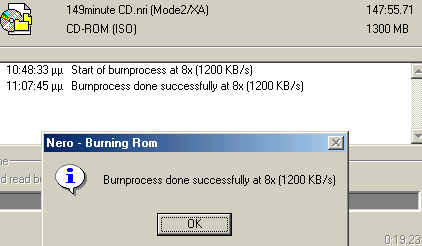
- Packet Writing
Tests:
The drive is packaged with Sony abCD v1.60/DirectCD v5.01s. We used
both InCD and abCD for our tests since we had some problems with InCD software.
After the first write/read attempt, the drive made 2 extra minutes to finish
the task and refused to read the written data:


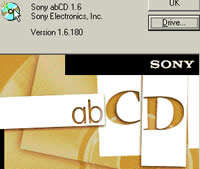 For
the same purpose, we also used Sony abCD. We used Verbatim HS-RW media and we
formatted it. The formatting of the media takes around 9min.The formatted disc
had 534mbs of free space. We copied a 403 MB file (403.147 kbs) from a Hard
Disk (on the same PC as the writers) to the formatted RW media using Explorer
(we dragged and dropped) and we completed the test twice to eliminate any possible
time measurement faults and user errors:
For
the same purpose, we also used Sony abCD. We used Verbatim HS-RW media and we
formatted it. The formatting of the media takes around 9min.The formatted disc
had 534mbs of free space. We copied a 403 MB file (403.147 kbs) from a Hard
Disk (on the same PC as the writers) to the formatted RW media using Explorer
(we dragged and dropped) and we completed the test twice to eliminate any possible
time measurement faults and user errors:

The drive has a good packet writing speed for a 8x rewriter with 5.74X writing
and 10.96X reading. The competition of course if faster due to different re-writing
speeds.
DDCD-RW Packet Writing
Tests
We formatted the DDCD-R media with Sony abCD v1.60. The format process took
around 18minutes to complete, and after that the CD had more than 1GB of empty
space!

For our tests we used the same way we tested normal CDR-W drives. We selected
files which total size was around 995MBs (994.933kbs). The drive needed around
16:40minutes to write the files and around 16:46minutes to read them. The final
writing/reading speeds are satisfactory if we keep in mind the file size and
also the fact that the drive can re-write at only 8x:
|
Write Speed
|
Read Speed
|
|
5.68x
|
5.62x
|
8. Conclusion
Sony
CRX200E IDE DDCD-RW- Page
8
Conclusion
|
Positive
(+):
|
Negative
(-):
|
|
- Supports new DDCD format (1.3GB)
- Supports 12x writing speed
- Supports 8MB of buffer
- Good CloneCD reading performance
- Supports HS-RW standard
- Supports DAO-RAW
- Supports CD-Text (read/write)
- Supports reading of SubChannel data
- Good packet writing performance
- Package contains DDCD-R/DDCD-RW media
- Supports UDMA-33
|
-
No anti-coaster technology
- DAE locked at 12x
- DAE ripping quality is not perfect
- Burning times are higher than the rest drives
- Doesn't support overburning
- Doesn't support 90/99min CDs
- Problems with Prodisc media at 12x
- Doesn't backup SD2 protected CDs
|
The Sony CRX200E is the first drive ever to support the DDCD (Double Density)
format. The new format promises up to 1.3GB of storage data, which will make
a lot of users happy. The drive's overall performance is good, although there
are several issues that will trouble some users. The lack of any anti-coaster
technology and overburning capability is not a positive point, since the competition
already offers it. In addition the DAE is locked at 12x and isn't perfect as
the CD Speed 99 Advanced DAE showed. Users will be pleased from the drive's
DAO-RAW support and reading of SubChannel data, even if it cannot produce working
SD2 backups.
Our tests with DDCD-R/W media were a complete success, and you can have up
to 1.3GB of data in one single CD if you like! The prices for the media are
cheap (2-3$) and they will soon be available in all the stores. The drive's
price is around 217$, 70$ higher than the rest of the 12/10/32 CDR-W drives,
and in the same price level with a 16x writer!
You must ask yourself if you want the 1.3GB that the new DDCD format offers
or not. If you are looking for additional storage space and cannot afford the
cash for a DVD-R/RW burner, then this drive is suitable for you...